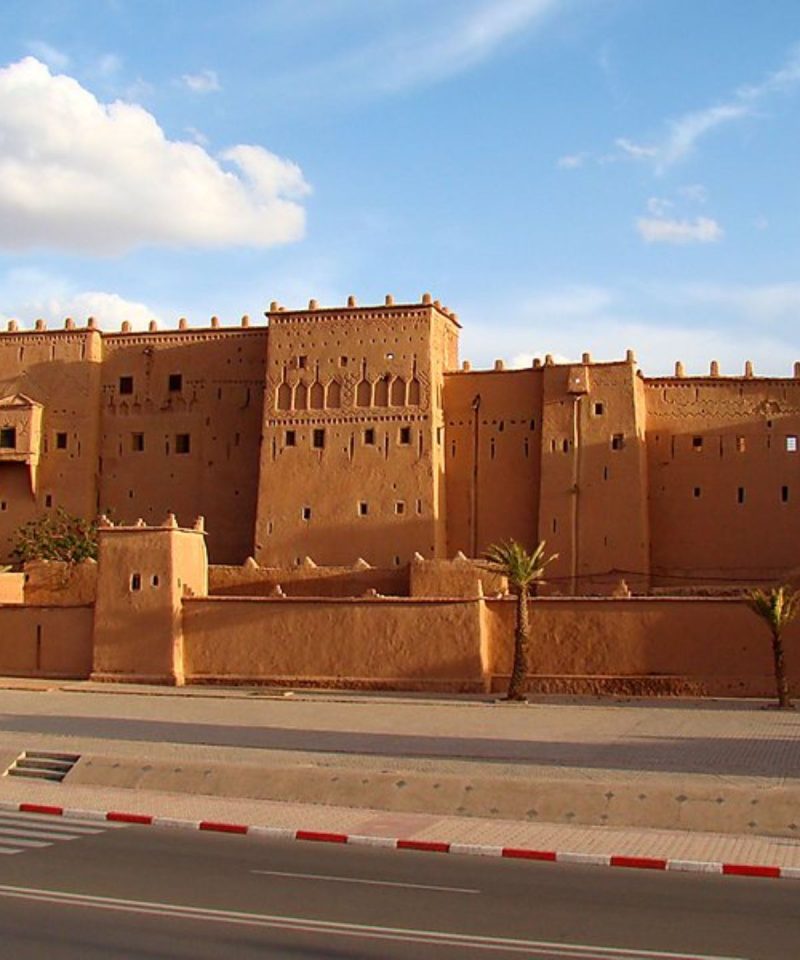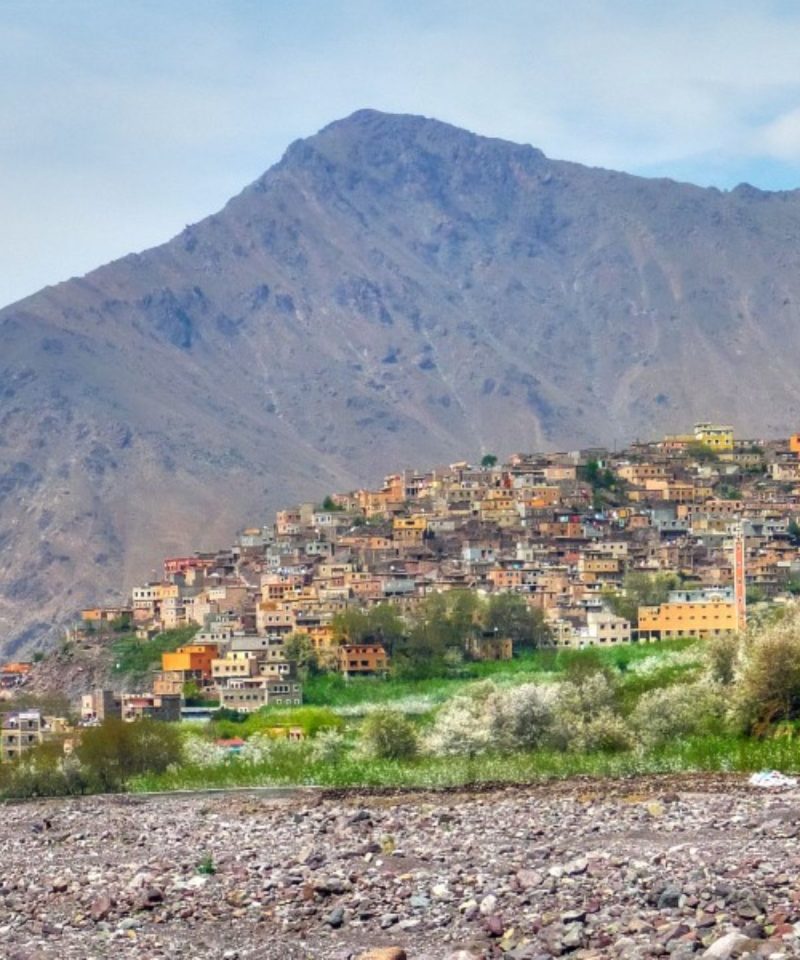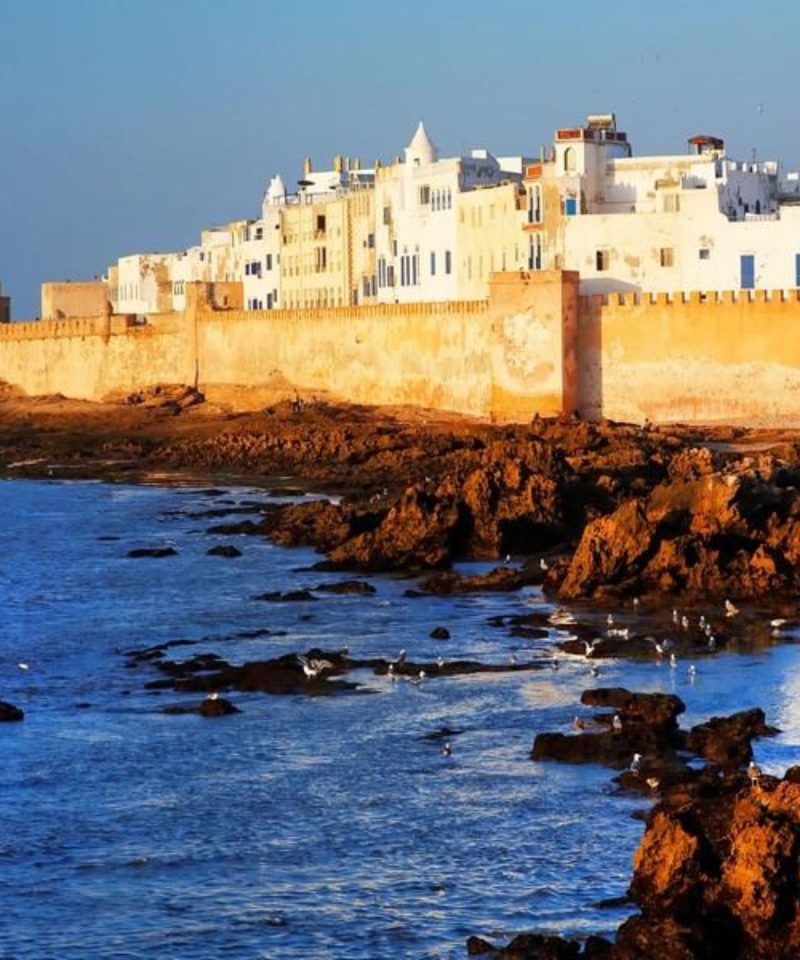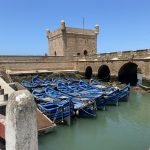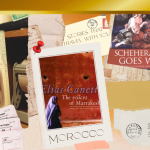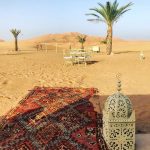Etymology
The exact meaning of the name is debated. One possible origin of the name Marrakesh is from the Berber (Amazigh) words amur (n) akush (ⴰⵎⵓⵔ ⵏ ⴰⴽⵓⵛ), which means “Land of God”. According to historian Susan Searight, however, the town’s name was first documented in an 11th-century manuscript in the Qarawiyyin library in Fez, where its meaning was given as “country of the sons of Kush”. The word mur is used now in Berber mostly in the feminine form tamurt. The same word “mur” appears in Mauretania, the North African kingdom from antiquity, although the link remains controversial as this name possibly originates from μαύρος mavros, the ancient Greek word for black. The common English spelling is “Marrakesh”, although “Marrakech” (the French spelling) is also widely used. The name is spelled Mṛṛakc in the Berber Latin alphabet, Marraquexe in Portuguese, Marrakech in Spanish. A typical pronunciation in Moroccan Arabic is marrākesh with stress on the second syllable, while vowels in the other syllables may be barely pronounced.
From medieval times until around the beginning of the 20th century, the entire country of Morocco was known as the “Kingdom of Marrakesh”, as the kingdom’s historic capital city was often Marrakesh. The name for Morocco is still “Marrakesh” (مراكش) to this day in Persian and Urdu as well as many other South Asian languages. Various European names for Morocco (Marruecos, Marrocos, Maroc, Marokko, etc.) are directly derived from the Berber word Murakush. Conversely, the city itself was in earlier times simply called Marocco City (or similar) by travelers from abroad. The name of the city and the country diverged after the Treaty of Fez divided Morocco into a French protectorate in Morocco and Spanish protectorate in Morocco, and the old interchangeable usage lasted widely until about the interregnum of Mohammed Ben Aarafa (1953–1955). The latter episode set in motion the country’s return to independence, when Morocco officially became المملكة المغربية (al-Mamlaka al-Maġribiyya, “The Maghreb Kingdom”), its name no longer referring to the city of Marrakesh. Marrakesh is known by a variety of nicknames, including the “Red City”, the “Ochre City” and “the Daughter of the Desert”, and has been the focus of poetic analogies such as one comparing the city to “a drum that beats an African identity into the complex soul of Morocco.”
History
Main articles: History of Marrakesh and Timeline of Marrakesh
The Marrakesh area was inhabited by Berber farmers from Neolithic times, and numerous stone implements have been unearthed in the area. Marrakesh was founded by Abu Bakr ibn Umar, chieftain and second cousin of the Almoravid king Yusuf ibn Tashfin (c. 1061–1106).Historical sources cite a variety of dates for this event ranging between 1062 (454 in the Hijri calendar), according to Ibn Abi Zar and Ibn Khaldun, and 1078 (470 AH), according to Muhammad al-Idrisi. The date most commonly accepted by modern historians is 1070 although 1062 is still cited by some writers. The Almoravids, a Berber dynasty seeking to reform Islamic society, ruled an emirate stretching from the edge of Senegal to the centre of Spain and from the Atlantic coast to Algiers. They used Marrakesh as their capital and established its first structures, including mosques and a fortified residence, the Ksar al-Hajjar, near the present-day Kutubiyya Mosque. These Almoravid foundations also influenced the layout and urban organization of the city for centuries to come. For example, the present-day Jemaa el-Fnaa originated from a public square in front of the Almoravid palace gates, the Rahbat al-Ksar, and the major souks (markets) of the city developed roughly in the area between this square and the city’s main mosque, where they remain today. The city developed the community into a trading centre for the Maghreb and sub-Saharan Africa. It grew rapidly and established itself as a cultural and religious centre, supplanting Aghmat, which had long been the capital of Haouz. Andalusi craftsmen from Cordoba and Seville built and decorated numerous monuments, importing the Cordoban Umayyad style characterised by carved domes and cusped arches. This Andalusian influence merged with designs from the Sahara and West Africa, creating a unique style of architecture which was fully adapted to the Marrakesh environment. Yusuf ibn Tashfin built houses, minted coins, and brought gold and silver to the city in caravans. His son and successor, Ali Ibn Yusuf, built the Ben Youssef Mosque, the city’s main mosque, between 1120 and 1132. He also fortified the city with city walls for the first time in 1126–1127 and expanded its water supply by creating the underground water system known as the khettara.
In 1125, the preacher Ibn Tumart settled in Tin Mal in the mountains to the south of Marrakesh, founding the Almohad movement. This new faction, composed mainly of Masmuda tribesmen, followed a doctrine of radical reform with Ibn Tumart as the mahdi, a messianic figure. He preached against the Almoravids and influenced a revolt which succeeded in bringing about the fall of nearby Aghmat, but stopped short of bringing down Marrakesh following an unsuccessful siege in 1130. Ibn Tumart died shortly after in the same year, but his successor Abd al-Mu’min took over the political leadership of the movement and captured Marrakesh in 1147 after a siege of several months. The Almohads purged the Almoravid population over three days and established the city as their new capital. They went on to take over much of the Almoravids’ former territory in Africa and the Iberian Peninsula. In 1147, shortly after the city’s conquest, Abd al-Mu’min founded the Kutubiyya Mosque (or Koutoubia Mosque), next to the former Almoravid palace, to serve as the city’s new main mosque. The Almoravid mosques were either demolished or abandoned as the Almohads enacted their religious reforms. Abd al-Mu’min was also responsible for establishing the Menara Gardens in 1157, while his successor Abu Ya’qub Yusuf (r. 1163–1184) began the Agdal Gardens. Ya’qub al-Mansur (r. 1184–1199), possibly on the orders of his father Abu Ya’qub Yusuf, was responsible for building the Kasbah, a citadel and palace district on the south side of the city. The Kasbah housed the center of government and the residence of the caliph, a title borne by the Almohad rulers to rival the eastern Abbasid Caliphate. In part because of these various additions, the Almohads also improved the water supply system and created water reservoirs to irrigate their gardens. Thanks to its economic, political, and cultural importance, Marrakesh hosted many writers, artists, and intellectuals, many of them from Al-Andalus, including the famous philosopher Averroes of Cordoba.
The death of Yusuf II in 1224 began a period of instability. Marrakesh became the stronghold of the Almohad tribal sheikhs and the ahl ad-dar (descendants of Ibn Tumart), who sought to claw power back from the ruling Almohad family. Marrakesh was taken, lost and retaken by force multiple times by a stream of caliphs and pretenders, such as during the brutal seizure of Marrakesh by the Sevillan caliph Abd al-Wahid II al-Ma’mun in 1226, which was followed by a massacre of the Almohad tribal sheikhs and their families and a public denunciation of Ibn Tumart’s doctrines by the caliph from the pulpit of the Kasbah Mosque. After al-Ma’mun’s death in 1232, his widow attempted to forcibly install her son, acquiring the support of the Almohad army chiefs and Spanish mercenaries with the promise to hand Marrakesh over to them for the sack. Hearing of the terms, the people of Marrakesh sought to make an agreement with the military captains and saved the city from destruction with a sizable payoff of 500,000 dinars. In 1269, Marrakesh was conquered by nomadic Zenata tribes who overran the last of the Almohads. The city then fell into a state of decline, which soon led to the loss of its status as capital to rival city Fez.
In the early 16th century, Marrakesh again became the capital of Morocco, after a period when it was the seat of the Hintata emirs. It quickly reestablished its status, especially during the reigns of the Saadian sultans Abdallah al-Ghalib and Ahmad al-Mansur. Thanks to the wealth amassed by the Sultans, Marrakesh was embellished with sumptuous palaces while its ruined monuments were restored. El Badi Palace, begun by Ahmad al-Mansur in 1578, was made with costly materials including marble from Italy. The palace was intended primarily for hosting lavish receptions for ambassadors from Spain, England, and the Ottoman Empire, showcasing Saadian Morocco as a nation whose power and influence reached as far as the borders of Niger and Mali. Under the Saadian dynasty, Marrakesh regained its former position as a point of contact for caravan routes from the Maghreb, the Mediterranean and sub-Saharan Africa.
For centuries Marrakesh has been known as the location of the tombs of Morocco’s seven patron saints (sebaatou rizjel). When sufism was at the height of its popularity during the late 17th-century reign of Moulay Ismail, the festival of these saints was founded by Abu Ali al-Hassan al-Yusi at the request of the sultan. The tombs of several renowned figures were moved to Marrakesh to attract pilgrims, and the pilgrimage associated with the seven saints is now a firmly established institution. Pilgrims visit the tombs of the saints in a specific order, as follows: Sidi Yusuf Ali Sanhaji (1196–97), a leper; Qadi Iyyad or qadi of Ceuta (1083–1149), a theologian and author of Ash-Shifa (treatises on the virtues of Muhammad); Sidi Bel Abbas (1130–1204), known as the patron saint of the city and most revered in the region; Sidi Muhammad al-Jazuli (1465), a well known Sufi who founded the Jazuli brotherhood; Abdelaziz al-Tebaa (1508), a student of al-Jazuli; Abdallah al-Ghazwani (1528), known as Moulay al-Ksour; and Sidi Abu al-Qasim Al-Suhayli, (1185), also known as Imam al-Suhayli. Until 1867, European Christians were not authorized to enter the city unless they acquired special permission from the sultan; east European Jews were permitted.
During the early 20th century, Marrakesh underwent several years of unrest. After the premature death in 1900 of the grand vizier Ba Ahmed, who had been designated regent until the designated sultan Abd al-Aziz became of age, the country was plagued by anarchy, tribal revolts, the plotting of feudal lords, and European intrigues. In 1907, Marrakesh caliph Moulay Abd al-Hafid was proclaimed sultan by the powerful tribes of the High Atlas and by Ulama scholars who denied the legitimacy of his brother, Abd al-Aziz. It was also in 1907 that Dr. Mauchamp, a French doctor, was murdered in Marrakesh, suspected of spying for his country. France used the event as a pretext for sending its troops from the eastern Moroccan town of Oujda to the major metropolitan center of Casablanca in the west. The French colonial army encountered strong resistance from Ahmed al-Hiba, a son of Sheikh Ma al-‘Aynayn, who arrived from the Sahara accompanied by his nomadic Reguibat tribal warriors. On 30 March 1912, the French Protectorate in Morocco was established. After the Battle of Sidi Bou Othman, which saw the victory of the French Mangin column over the al-Hiba forces in September 1912, the French seized Marrakesh. The conquest was facilitated by the rallying of the Imzwarn tribes and their leaders from the powerful Glaoui family, leading to a massacre of Marrakesh citizens in the resulting turmoil.
T’hami El Glaoui, known as “Lord of the Atlas”, became Pasha of Marrakesh, a post he held virtually throughout the 44-year duration of the Protectorate (1912–1956). Glaoui dominated the city and became famous for his collaboration with the general residence authorities, culminating in a plot to dethrone Mohammed Ben Youssef (Mohammed V) and replace him with the Sultan’s cousin, Ben Arafa. Glaoui, already known for his amorous adventures and lavish lifestyle, became a symbol of Morocco’s colonial order. He could not, however, subdue the rise of nationalist sentiment, nor the hostility of a growing proportion of the inhabitants. Nor could he resist pressure from France, who agreed to terminate its Moroccan Protectorate in 1956 due to the launch of the Algerian War (1954–1962) immediately following the end of the war in Indochina (1946–1954), in which Moroccans had been conscripted to fight in Vietnam on behalf of the French Army. After two successive exiles to Corsica and Madagascar, Mohammed Ben Youssef was allowed to return to Morocco in November 1955, bringing an end to the despotic rule of Glaoui over Marrakesh and the surrounding region. A protocol giving independence to Morocco was then signed on 2 March 1956 between French Foreign Minister Christian Pineau and M’Barek Ben Bakkai.
Since the independence of Morocco, Marrakesh has thrived as a tourist destination. In the 1960s and early 1970s, the city became a trendy “hippie mecca”. It attracted numerous western rock stars and musicians, artists, film directors and actors, models, and fashion divas, leading tourism revenues to double in Morocco between 1965 and 1970. Yves Saint Laurent, The Beatles, The Rolling Stones and Jean-Paul Getty all spent significant time in the city; Laurent bought a property here and renovated the Majorelle Gardens. Expatriates, especially those from France, have invested heavily in Marrakesh since the 1960s and developed many of the riads and palaces. Old buildings were renovated in the Old Medina, new residences and commuter villages were built in the suburbs, and new hotels began to spring up.
United Nations agencies became active in Marrakesh beginning in the 1970s, and the city’s international political presence has subsequently grown. In 1985, UNESCO declared the old town area of Marrakesh a UNESCO World Heritage Site, raising international awareness of the cultural heritage of the city. In the 1980s, Patrick Guerand-Hermes purchased the 30 acres (12 ha) Ain el Quassimou, built by the family of Leo Tolstoy. On 15 April 1994, the Marrakesh Agreement was signed here to establish the World Trade Organisation, and in March 1997 Marrakesh served as the site of the World Water Council’s first World Water Forum, which was attended by over 500 international participants.
In the 21st century, property and real estate development in the city has boomed, with a dramatic increase in new hotels and shopping centres, fuelled by the policies of Mohammed VI of Morocco, who aims to increase the number of tourists annually visiting Morocco to 20 million by 2020. In 2010, a major gas explosion occurred in the city. On 28 April 2011, a bomb attack took place in the Jemaa el-Fnaa square, killing 15 people, mainly foreigners. The blast destroyed the nearby Argana Cafe. Police sources arrested three suspects and claimed the chief suspect was loyal to Al-Qaeda, although Al-Qaeda in the Islamic Maghreb denied involvement. In November 2016 the city hosted the 2016 United Nations Climate Change Conference.
Geography
By road, Marrakesh is 580 kilometres (360 mi) southwest of Tangier, 327 kilometres (203 mi) southwest of the Moroccan capital of Rabat, 239 kilometres (149 mi) southwest of Casablanca, 196 kilometres (122 mi) southwest of Beni Mellal, 177 kilometres (110 mi) east of Essaouira, and 246 kilometres (153 mi) northeast of Agadir. The city has expanded north from the old centre with suburbs such as Daoudiat, Diour El Massakine, Sidi Abbad, Sakar and Amerchich, to the southeast with Sidi Youssef Ben Ali, to the west with Massira and Targa, and southwest to M’hamid beyond the airport. On the P2017 road leading south out of the city are large villages such as Douar Lahna, Touggana, Lagouassem, and Lahebichate, leading eventually through desert to the town of Tahnaout at the edge of the High Atlas, the highest mountainous barrier in North Africa. The average elevation of the snow-covered High Atlas lies above 3,000 metres (9,800 ft). It is mainly composed of Jurassic limestone. The mountain range runs along the Atlantic coast, then rises to the east of Agadir and extends northeast into Algeria before disappearing into Tunisia.
The city is located in the Tensift River valley, with the Tensift River passing along the northern edge of the city. The Ourika River valley is about 30 kilometres (19 mi) south of Marrakesh. The “silvery valley of the Ourika river curving north towards Marrakesh”, and the “red heights of Jebel Yagour still capped with snow” to the south are sights in this area. David Prescott Barrows, who describes Marrakesh as Morocco’s “strangest city”, describes the landscape in the following terms: “The city lies some fifteen or twenty miles [25–30 km] from the foot of the Atlas mountains, which here rise to their grandest proportions. The spectacle of the mountains is superb. Through the clear desert air the eye can follow the rugged contours of the range for great distances to the north and eastward. The winter snows mantle them with white, and the turquoise sky gives a setting for their grey rocks and gleaming caps that is of unrivaled beauty.”
With 130,000 hectares of greenery and over 180,000 palm trees in its Palmeraie, Marrakesh is an oasis of rich plant variety. Throughout the seasons, fragrant orange, fig, pomegranate and olive trees display their color and fruits in Agdal Garden, Menara Garden and other gardens in the city. The city’s gardens feature numerous native plants alongside other species that have been imported over the course of the centuries, including giant bamboos, yuccas, papyrus, palm trees, banana trees, cypress, philodendrons, rose bushes, bougainvilleas, pines and various kinds of cactus plants.
Landmarks
Jemaa el-Fnaa
The Jemaa el-Fnaa is one of the best-known squares in Africa and is the center of city activity and trade. It has been described as a “world-famous square”, “a metaphorical urban icon, a bridge between the past and the present, the place where (spectacularized) Moroccan tradition encounters modernity.” It has been part of the UNESCO World Heritage site since 1985. The square’s name has several possible meanings; the most plausible etymology endorsed by historians is that it meant “ruined mosque” or “mosque of annihilation”, referring to the construction of a mosque within the square in the late 16th century that was left unfinished and fell into ruin. The square was originally an open space for markets located on the east side of the Ksar el-Hajjar, the main fortress and palace of the Almoravid dynasty who founded Marrakech. Following the takeover of the city by the Almohads, a new royal palace complex was founded to the south of the city (the Kasbah) and the old Almoravid palace was abandoned, but the market square remained. Subsequently, with the fluctuating fortunes of the city, Jemaa el-Fnaa saw periods of decline and renewal.
Historically this square was used for public executions by rulers who sought to maintain their power by frightening the public. The square attracted dwellers from the surrounding desert and mountains to trade here, and stalls were raised in the square from early in its history. The square attracted tradesmen, snake charmers (“wild, dark, frenzied men with long disheveled hair falling over their naked shoulders”), dancing boys of the Chleuh Atlas tribe, and musicians playing pipes, tambourines and African drums.Today the square attracts people from a diversity of social and ethnic backgrounds and tourists from all around the world. Snake charmers, acrobats, magicians, mystics, musicians, monkey trainers, herb sellers, story-tellers, dentists, pickpockets, and entertainers in medieval garb still populate the square.
Souks
Marrakech has the largest traditional market in Morocco and the image of the city is closely associated with its souks. Historically the souks of Marrakech were divided into retail areas for particular goods such as leather, carpets, metalwork and pottery. These divisions still roughly exist with significant overlap. Many of the souks sell items like carpets and rugs, traditional Muslim attire, leather bags, and lanterns. Haggling is still a very important part of trade in the souks.
One of the largest souks is Souk Semmarine, which sells everything from brightly coloured bejewelled sandals and slippers and leather pouffes to jewellery and kaftans.Souk Ableuh contains stalls which specialize in lemons, chilis, capers, pickles, green, red, and black olives, and mint, a common ingredient of Moroccan cuisine and tea. Similarly, Souk Kchacha specializes in dried fruit and nuts, including dates, figs, walnuts, cashews and apricots. Rahba Qedima contains stalls selling hand-woven baskets, natural perfumes, knitted hats, scarves, tee shirts, Ramadan tea, ginseng, and alligator and iguana skins. The Criée Berbère, to the northeast of this market, is noted for its dark Berber carpets and rugs. Souk Siyyaghin is known for its jewellery, and Souk Smata nearby is noted for its extensive collection of babouches and belts. Souk Cherratine specializes in leatherware, and Souk Belaarif sells modern consumer goods. Souk Haddadine specializes in ironware and lanterns. The Medina is also famous for its street food. Mechoui Alley is particularly famous for selling slow-roasted lamb dishes. The Ensemble Artisanal, located near the Koutoubia Mosque, is a government-run complex of small arts and crafts which offers a range of leather goods, textiles and carpets. Young apprentices are taught a range of crafts in the workshop at the back of this complex.
City walls and gates
The ramparts of Marrakech, which stretch for some 19 kilometres (12 mi) around the medina of the city, were built by the Almoravids in the 12th century as protective fortifications. The walls are made of a distinct orange-red clay and chalk, giving the city its nickname as the “red city”; they stand up to 19 feet (5.8 m) high and have 20 gates and 200 towers along them.
Of the city’s gates, one of the best-known is Bab Agnaou, built in the late 12th century by the Almohad caliph Ya’qub al-Mansur as the main public entrance to the new Kasbah. The Berber name Agnaou, like Gnaoua, refers to people of Sub-Saharan African origin (cf. Akal-n-iguinawen – land of the black). The gate was called Bab al Kohl (the word kohl also meaning “black”) or Bab al Qsar (palace gate) in some historical sources. The corner-pieces are embellished with floral decorations. This ornamentation is framed by three panels marked with an inscription from the Quran in Maghrebi script using foliated Kufic letters, which were also used in Al-Andalus. Bab Agnaou was renovated and its opening reduced in size during the rule of sultan Mohammed ben Abdallah.
The medina has at least eight main historic gates: Bab Doukkala, Bab el-Khemis, Bab ad-Debbagh, Bab Aylan, Bab Aghmat, Bab er-Robb, Bab el-Makhzen and Bab el-‘Arissa. These date back to the 12th century during the Almoravid period and many have them have been modified since. Bab Doukkala (in the northwestern part of the city wall) is in general more massive and less ornamented than the other gates; it takes its name from Doukkala area on the Atlantic coast, well to the north of Marrakesh.Bab el-Khemis is in the medina’s northeastern corner and is named for the open-air Thursday market (Souq el Khemis). It is one of the city’s main gates and features a man-made spring. Bab ad-Debbagh, to the east, has one of the most complex layouts of any gate, with an interior passage that turns multiple times. Bab Aylan is located slightly further south of it. Bab Aghmat is one of the city’s main southern gates, located east of the Jewish and Muslim cemeteries and near the tomb of Ali ibn Yusuf.Bab er Robb is the other main southern exit from the city, located near Bab Agnaou. It has a curious position and layout which may be the result of multiple modifications to the surrounding area over the years. It provides access to roads leading to the mountain towns of Amizmiz and Asni.
Gardens
The city is home to a number of gardens, both historical and modern. The largest and oldest gardens in the city are the Menara gardens to the west and the Agdal Gardens to the south. The Menara Gardens were established in 1157 by the Almohad ruler Abd al-Mu’min. They are centered around a large water reservoir surrounded by orchards and olive groves. A 19th-century pavilion stands at the edge of the reservoir. The Agdal Gardens were established during the reign of Abu Ya’qub Yusuf (r. 1163–1184) and extend over a larger area today, containing several water basins and palace structures. The Agdal Gardens cover about 340 hectares (1.3 sq mi) and are surrounded by a circuit of pisé walls, while the Menara Gardens cover around 96 hectares (0.37 sq mi). The water reservoirs for both gardens were supplied with water through an old hydraulic system known as khettaras, which conveyed water from the foothills of the nearby Atlas Mountains.
The Majorelle Garden, on Avenue Yacoub el Mansour, was at one time the home of the landscape painter Jacques Majorelle. Famed designer Yves Saint Laurent bought and restored the property, which features a stele erected in his memory, and the Museum of Islamic Art, which is housed in a dark blue building. The garden, open to the public since 1947, has a large collection of plants from five continents including cacti, palms and bamboo.
The Koutoubia Mosque is also flanked by another set of gardens, the Koutoubia Gardens. They feature orange and palm trees, and are frequented by storks. The Mamounia Gardens, more than 100 years old and named after Prince Moulay Mamoun, have olive and orange trees as well as a variety of floral displays.] In 2016, artist André Heller opened the acclaimed garden ANIMA near Ourika, which combines a large collection of plants, palms, bamboo and cacti as well as works by Keith Haring, Auguste Rodin, Hans Werner Geerdts and other artists.
Palaces and Riads
The historic wealth of the city is manifested in palaces, mansions and other lavish residences. The best-known palaces today are the El Badi Palace and the Bahia Palace, as well as the main Royal Palace which is still in use as one of the official residences of the King of Morocco. Riads (Moroccan mansions, historically designating a type of garden) are common in Marrakesh. Based on the design of the Roman villa, they are characterized by an open central garden courtyard surrounded by high walls. This construction provided the occupants with privacy and lowered the temperature within the building. Numerous riads and historic residences exist through the old city, with the oldest documented examples dating back to the Saadian period (16th-17th centuries), while many others date from the 19th and 20th centuries.
Mosques
The Koutoubia Mosque is one of the largest and most famous mosques in the city, located southwest of Jemaa el-Fnaa. The mosque was founded in 1147 by the Almohad caliph Abd al-Mu’min. A second version of the mosque was entirely rebuilt by Abd al-Mu’min around 1158, with Ya’qub al-Mansur possibly finalizing construction of the minaret around 1195. This second mosque is the structure that stands today. It is considered a major example of Almohad architecture and of Moroccan mosque architecture generally. Its minaret tower, the tallest in the city at 77 metres (253 ft) in height, is considered an important landmark and symbol of Marrakesh. It likely influenced other buildings such as the Giralda of Seville and the Hassan Tower of Rabat.
Ben Youssef Mosque is named after the Almoravid sultan Ali ibn Yusuf, who built the original mosque in the 12th century to serve as the city’s main Friday mosque. After being abandoned during the Almohad period and falling into ruin, it was rebuilt in the 1560s by Abdallah al-Ghalib and then completely rebuilt again Moulay Sliman at the beginning of the 19th century. The 16th-century Ben Youssef Madrasa is located next to it. Also next to it is the Koubba Ba’adiyn or Almoravid Koubba, a rare architectural remnant of the Almoravid period which was excavated and restored in the 20th century. The Koubba, a domed kiosk structure, demonstrates a sophisticated style and is an important indication of the art and architecture of the period.
The Kasbah Mosque overlooks Place Moulay Yazid in the Kasbah district of Marrakesh, close to the El Badi Palace. It was built by the Almohad caliph Yaqub al-Mansour in the late 12th century to serve as the main mosque of the kasbah (citadel) where he and his high officials resided. It contended with the Koutoubia Mosque for prestige and the decoration of its minaret was highly influential in subsequent Moroccan architecture. The mosque was repaired by the Saadi sultan Moulay Abdallah al-Ghalib following a devastating explosion at a nearby gunpowder reserve in the second half of the 16th century. Notably, the Saadian Tombs were built just outside its southern wall in this period.
Among the other notable mosques of the city is the 14th-century Ben Salah Mosque, located east of the medina centre. It is one of the only major Marinid-era monuments in the city. The Mouassine Mosque (also known as the Al Ashraf Mosque) was built by the Saadian sultan Abdallah al-Ghalib between 1562–63 and 1572–73. It was part of a larger architectural complex which included a library, hammam (public bathhouse), and a madrasa (school). The complex also included a large ornate street fountain known as the Mouassine Fountain, which still exists today. The Bab Doukkala Mosque, built around the same time further west, has a similar layout and style as the Mouassine Mosque. Both the Mouassine and Bab Doukkala mosques appear to have been originally designed to anchor the development of new neighbourhoods after the relocation of the Jewish district from this area to the new mellah near the Kasbah.
Tombs
One of the most famous funerary monuments in the city is the Saadian Tombs, which were built in the 16th century as a royal necropolis for the Saadian Dynasty. It is located next to the south wall of the Kasbah Mosque. The necropolis contains the tombs of many Saadian rulers including Muhammad al-Shaykh, Abdallah al-Ghalib, and Ahmad al-Mansur, as well as various family members and later sultans. It consists of two main structures, each with several rooms, standing within a garden enclosure. The most important graves are marked by horizontal tombstones of finely carved marble, while others are merely covered in colorful zellij tiles. Al-Mansur’s mausoleum chamber is especially rich in decoration, with a roof of carved and painted cedar wood supported on twelve columns of carrara marble, and with walls decorated with geometric patterns in zellij tilework and vegetal motifs in carved stucco. The chamber next to it, originally a prayer room equipped with a mihrab, was later repurposed as a mausoleum for members of the Alaouite dynasty.
The city also holds the tombs of many Sufi figures. Of these, there are seven patron saints of the city, which are visited every year by pilgrims during the seven-day ziara pilgrimage. During this time pilgrims visit the tombs in the following order: Sidi Yusuf ibn Ali Sanhaji, Sidi al-Qadi Iyyad al-Yahsubi, Sidi Bel Abbas, Sidi Mohamed ibn Sulayman al-Jazouli, Sidi Abdellaziz Tabba’a, Sidi Abdellah al-Ghazwani, and lastly, Sidi Abderrahman al-Suhayli. Many of these mausoleums also serve as the focus of their own zawiyas (Sufi religious complexes with mosques), including: the Zawiya and mosque of Sidi Bel Abbes (the most important of them), the Zawiya of al-Jazuli, the Zawiya of Sidi Abdellaziz, the Zawiya of Sidi Yusuf ibn Ali, and the Zawiya of Sidi al-Ghazwani (also known as Moulay el-Ksour).
Mellah
The Mellah of Marrakesh is the old Jewish Quarter (Mellah) of the city, located is in the kasbah area of the city’s medina, east of Place des Ferblantiers. It was created in 1558 by the Saadians at the site where the sultan’s stables were. At the time, the Jewish community consisted of a large portion of the city’s tailors, metalworkers, bankers, jewelers, and sugar traders. During the 16th century, the Mellah had its own fountains, gardens, synagogues and souks. Until the arrival of the French in 1912, Jews could not own property outside of the Mellah; all growth was consequently contained within the limits of the neighborhood, resulting in narrow streets, small shops and higher residential buildings. The Mellah, today reconfigured as a mainly residential zone renamed Hay Essalam, currently occupies an area smaller than its historic limits and has an almost entirely Muslim population. The Slat al-Azama Synagogue (or Lazama Synagogue), built around a central courtyard, is in the Mellah. The Jewish cemetery here is the largest of its kind in Morocco. Characterized by white-washed tombs and sandy graves, the cemetery is within the Medina on land adjacent to the Mellah. According to the World Jewish Congress there were only 250 Moroccan Jews remaining in Marakesh.
Hotels
As one of the principal tourist cities in Africa, Marrakech has over 400 hotels. Mamounia Hotel is a five-star hotel in the Art Deco-Moroccan fusion style, built in 1925 by Henri Prost and A. Marchis. It is considered the most eminent hotel of the city and has been described as the “grand dame of Marrakech hotels.” The hotel has hosted numerous internationally renowned people including Winston Churchill, Prince Charles of Wales and Mick Jagger. Churchill used to relax within the gardens of the hotel and paint there. The 231-room hotel, which contains a casino, was refurbished in 1986 and again in 2007 by French designer Jacques Garcia. Other hotels include Eden Andalou Hotel, Hotel Marrakech, Sofitel Marrakech, Palm Plaza Hotel & Spa, Royal Mirage Hotel, Piscina del Hotel, and Palmeraie Palace at the Palmeraie Rotana Resort. In March 2012, Accor opened its first Pullman-branded hotel in Marrakech, Pullman Marrakech Palmeraie Resort & Spa. Set in a 17 hectares (42 acres) olive grove at La Palmeraie, the hotel has 252 rooms, 16 suites, six restaurants and a 535 square metres (5,760 sq ft) conference room.

